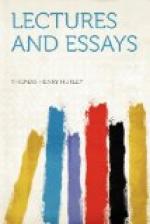[Footnote 34: See, for an admirable discussion of the whole subject, Dr. Abbott’s article on the Gospels in the Encyclopaedia Britannica; and the remarkable monograph by Professor Volkmar, Jesus Nazarenus und die erste christliche Zeit (1882). Whether we agree with the conclusions of these writers or not, the method of critical investigation which they adopt is unimpeachable.]
[Footnote 35: Notwithstanding the hard words shot at me from behind the hedge of anonymity by a writer in a recent number of the Quarterly Review, I repeat, without the slightest fear of refutation, that the four Gospels, as they have come to us, are the work of unknown writers.]
[Footnote 36: Their arguments, in the long run, are always reducible to one form. Otherwise trustworthy witnesses affirm that such and such events took place. These events are inexplicable, except the agency of “spirits” is admitted. Therefore “spirits” were the cause of the phenomena.
And the heads of the reply are always the same. Remember Goethe’s aphorism: “Alles factische ist schon Theorie.” Trustworthy witnesses are constantly deceived, or deceive themselves, in their interpretation of sensible phenomena. No one can prove that the sensible phenomena, in these cases, could be caused only by the agency of spirits: and there is abundant ground for believing that they may be produced in other ways. Therefore, the utmost that can be reasonably asked for, on the evidence as it stands, is suspension of judgment. And, on the necessity for even that suspension, reasonable men may differ, according to their views of probability.]
[Footnote 37: Yet I must somehow have laid hold of the pith of the matter, for, many years afterwards, when Dean Mansel’s Bampton Lectures were published, it seemed to me I already knew all that this eminently agnostic thinker had to tell me.]
[Footnote 38: Kritik der reinen Vernunft. Edit. Hartenstein p. 256.]
[Footnote 39: Report of the Church Congress, Manchester, 1888, p. 252.]
[Footnote 40: I suppose this is what Dr. Wace is thinking about when he says that I allege that there “is no visible escape” from the supposition of an Ur-Marcus (p. 367). That a “theologian of repute should confound an indisputable fact with one of the modes of explaining that fact is not so singular as those who are unaccustomed to the ways of theologians might imagine.]
[Footnote 41: Any examiner whose duty it has been to examine into a case of “copying” will be particularly well prepared to appreciate the force of the case stated in that most excellent little book, The Common Tradition of the Synoptic Gospels, by Dr. Abbott and Mr. Rushbrooke (Macmillan, 1884). To those who have not passed through such painful experiences I may recommend the brief discussion of the genuineness of the “Casket Letters” in my friend Mr. Skelton’s interesting book,




